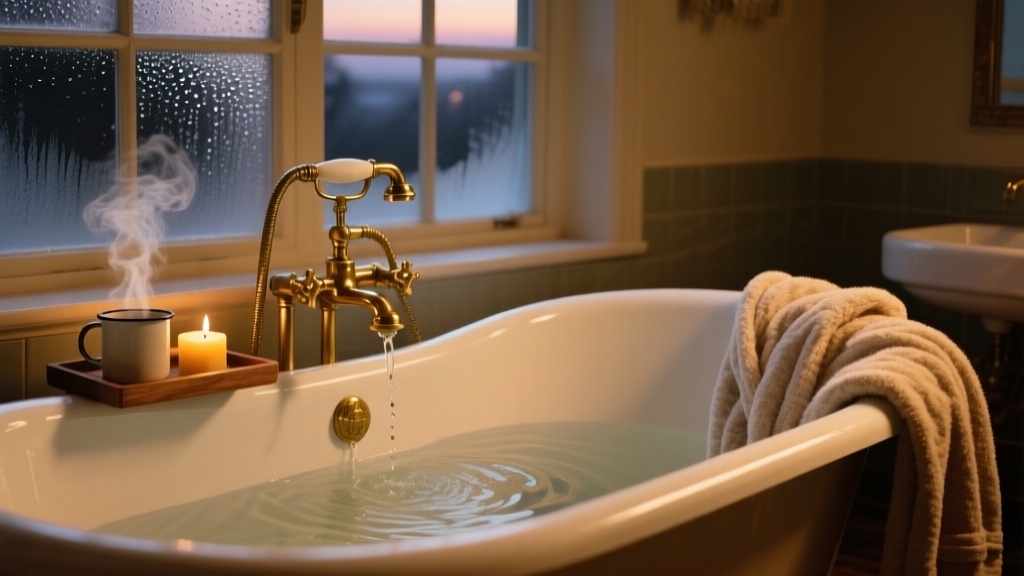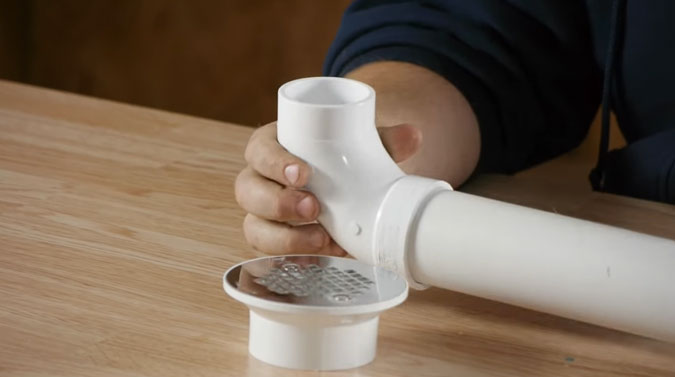To keep your bathwater hot, start by preheating the tub and bathroom to reduce heat loss. Use a well-insulated cover to minimize evaporation and surface cooling. Add bubble bath foam or bath oils to create a thermal barrier on the water’s surface.
Consider placing pre-warmed basalt stones for gradual heat release. Seal drafts and choose tubs made from heat-retentive materials. Maintain water temperature by adding hot water in small increments and stirring regularly.
Explore these strategies further to maximize warmth and comfort.
Key Takeaways
- Preheat the tub and bathroom to reduce temperature loss before filling with hot water.
- Use insulating covers and foam lids on the tub surface to minimize heat loss and evaporation.
- Add hot water gradually and stir regularly to maintain an even, steady water temperature.
- Incorporate bubble bath foam or bath oils to create a thermal barrier on the water surface.
- Place pre-warmed basalt stones or use insulating wraps around the tub to extend warmth retention.
Preheating the Tub and Bathroom
Although you might overlook it, preheating your bathroom and tub can considerably slow the cooling of bathwater.
Raising the ambient temperature about 30 minutes before bathing reduces the temperature gradient between the water and air, lowering heat convection from the tub.
Preheating the bathroom 30 minutes ahead minimizes heat loss by reducing the water-air temperature difference.
Use built-in or portable heaters placed strategically to warm the room efficiently without wasting energy. This method helps reduce the thermal losses that exponentially increase when water cools rapidly, as seen in shower systems with low flow rates and slow hot water delivery thermal losses.
Installing devices with flow rate compatibility ensures optimal heater performance and energy efficiency. Additionally, warming the tub surface before filling slows heat transfer from water to the tub material, preserving water temperature longer.
Electric mats or surface heaters provide even heat distribution, preventing damage or uneven contraction.
Preheating both the room and tub stabilizes the thermal environment, optimizing heat retention.
This approach offers a practical, energy-conscious method to maintain bathwater warmth, enhancing comfort without unnecessary energy expenditure.
Using Bath Covers and Insulation
When you cover your bathwater with an insulating lid, you considerably slow heat loss from the surface, which is the primary area where warmth escapes. Submersible pumps use a sealed construction to prevent leaks, similarly emphasizing the importance of containment to maintain efficiency.
Bath covers made from closed-cell foam or reflective foil can reduce heat loss by up to 70%, extending water temperature retention by 30–60 minutes.
Additionally, insulating the tub structure further minimizes heat loss through walls and floors. To maximize heat retention:
- Use a snug-fitting, high-quality bath cover with foam or foil layers.
- Insulate beneath and around the tub with moisture-resistant spray foam. Proper insulation also reduces the workload on your HVAC system by limiting heat transfer, which improves energy efficiency energy efficiency.
- Combine covers and structural insulation for up to 80% total heat loss reduction.
- Maintain covers regularly to prevent mold and ensure hygiene.
This approach saves energy and maintains a warmer bath longer.
Adding Bubble Bath or Bath Oils
Beyond using bath covers and insulation, you can enhance heat retention by adding bubble bath or bath oils.
Bubble bath creates a thick, stable foam layer that acts as a thermal barrier, reducing heat loss by limiting evaporation and air diffusion. This method is especially effective since bubble baths provide better insulation compared to plain water. It is important to use manufacturer-specific ingredients to ensure safety and effectiveness.
Bath oils form a thin surface film that slows cooling by minimizing water evaporation. While bubbles provide better insulation, oils contribute to warmth and skin moisture but may leave residue.
| Feature | Bubble Bath |
|---|---|
| Heat Retention | High – stable foam insulates |
| Application | Add during or after filling tub |
| Maintenance | Can be replenished mid-bath |
| Feature | Bath Oils |
| Heat Retention | Moderate – surface film reduces evaporation |
| Application | Add immediately after filling |
| Maintenance | Replenish for extended warmth |
Utilizing Hot Stones or Heat Sources
Since hot stones retain and release heat gradually, you can use them as an effective way to maintain bathwater temperature longer. Hot stones slowly release heat, making them a great natural method to keep your bathwater warm longer.
Basalt stones, known for their density and smooth, non-porous surface, are ideal. Preheat stones safely at 120–135°F (49–57°C) before adding them to water. Monitor temperature frequently to avoid overheating.
Maintain the heating device within the safe temperature range to prevent the stones from becoming excessively hot or unevenly heated temperature management. Using materials resistant to degradation ensures consistent heat retention and safety during use.
Keep these tips in mind:
- Use stones designed for baths to ensure safety and maximum heat transfer.
- Add stones in intervals during your bath to sustain warmth.
- Place stones evenly for consistent heat distribution.
- Combine with slightly warmer water and a partial cover for best results.
This method extends warmth, soaks muscles, and enhances your bathing experience effectively by reducing the need for frequent reheating through long-lasting protection.
Minimizing Drafts and Airflow
Although maintaining hot stones in your bath helps retain heat, minimizing drafts and airflow around your tub plays an essential role in preventing rapid heat loss. You need to seal gaps near windows, doors, and vents to reduce cold air intrusion.
Using draft stoppers or weather stripping effectively blocks airflow. Also, consider positioning your tub away from direct pathways of air currents.
Before starting any home improvement, ensure you have the proper tools and materials ready to handle the task efficiently.
| Source of Draft | Solution | Effectiveness (%) |
|---|---|---|
| Window gaps | Weather stripping | 85 |
| Door undercuts | Draft stoppers | 90 |
| Vent openings | Adjustable vent covers | 75 |
| Room airflow | Rearranging furniture | 60 |
Selecting Heat-Retentive Tub Materials
When choosing a tub to keep your bathwater hot, the material plays a crucial role in heat retention and overall performance. Here’s what you need to contemplate:
- Cast Iron: Offers superior heat retention and radiates warmth back into water. Heavy, durable, but costly and requires reinforced flooring.
- Acrylic: Lightweight and easier to install with good heat retention. Fiberglass reinforcement improves durability and thermal performance.
- Porcelain-Enameled Steel: Affordable and strong but loses heat quickly. Prone to chipping and rust if damaged.
- Composite: Balances heat retention and weight, outperforming basic acrylic but falling short of cast iron. Durable and design-flexible.
Choose based on your budget, installation constraints, and desired heat retention to maximize your bath’s warmth efficiently. Additionally, proper maintenance and avoiding corrosive substances are essential to preserve the durability and longevity of your tub material.
Maintaining Optimal Water Temperature
To maintain ideal water temperature during your bath, you need to manage heat loss actively by adding hot water in small increments and stirring regularly. This prevents large temperature drops and distributes heat evenly, avoiding cold spots.
Bath water temperatures above 42°C (107°F) increase risks such as burns and dizziness, so it is important to keep the temperature within a safe range ≤42°C (107°F).
Drain cooler water before adding hot water to sustain warmth without sudden fluctuations. Avoid pouring boiling water directly to prevent scalding. Use thermostatic faucets for precise control. Additionally, controlling humidity levels in the bathroom can contribute to a more comfortable and stable bathing environment.
Keep the bathroom door closed to minimize drafts and maintain a warm environment, which slows water cooling. Preheat the tub surface by running hot water over it before filling to reduce heat absorbed by the tub material.
Start with slightly hotter water than desired to compensate for heat loss. These combined strategies help maintain a steady, comfortable water temperature throughout your bath.
Enhancing Heat Retention With Accessories
Since water loses heat primarily through its surface and tub walls, using accessories designed to enhance heat retention can substantially extend your bath’s warmth.
You can maximize heat retention effectively by integrating the following:
- Bath Covers – Limit heat loss and evaporation by covering unused tub areas with plastic or wood covers. These covers work by reducing the exposed water surface area, which is a primary source of heat loss.
- Bubble Baths and Oils – Create an insulating surface layer that slows cooling while adding skin benefits.
- Hot Stones – Pre-warmed basalt stones release heat gradually, maintaining water temperature longer.
- Insulating Wraps – Neoprene or thermal fabric wraps minimize heat loss from tub sides and bottom, ideal for freestanding tubs.
Incorporating these accessories helps you maintain optimal bathwater temperature efficiently. This extends your comfort and enjoyment without constant reheating.
Frequently Asked Questions
Can Adding Salt to Bathwater Help Retain Heat Longer?
Yes, adding bath salts like Epsom salt can help you retain heat longer in your bathwater.
The minerals increase water density, slowing heat loss, especially in baths lasting over 15 minutes.
You’ll notice your skin stays warmer, and the water temperature drops more slowly.
However, the effect depends on salt type, concentration, and bath conditions.
For the best results, use mineral-rich salts and soak longer than 10–20 minutes.
Does Water Hardness Affect How Quickly Bathwater Cools?
You might be surprised to learn that water hardness, measured in ppm of CaCO₃, doesn’t noticeably affect bathwater cooling rates.
Although hard water contains dissolved minerals, their impact on thermal capacity is negligible for typical bath volumes.
The primary heat loss comes from evaporation and conduction, influenced more by tub material and insulation.
How Often Should Bathwater Be Changed to Maintain Hygiene?
You should change bathwater before every use to maintain hygiene. Reusing water increases bacterial growth, skin cell buildup, and infection risk, especially at body temperature.
Even if you bathe infrequently, fresh water is essential. For multiple users or visible contamination, change immediately.
In home settings without filtration or sanitizers, single-use water is best practice to guarantee skin health and prevent pathogen transmission.
Are Electric Bath Heaters Safe to Use in Home Tubs?
You might worry about electric bath heaters being risky, but they’re actually safe if you follow guidelines.
Most have built-in safety features like automatic shut-offs and thermal cutoffs to prevent overheating.
Use only UL-listed models, install them properly, preferably by a licensed professional, and always plug into GFCI outlets.
Regular inspection and avoiding dry operation keep things secure.
With these precautions, electric bath heaters offer safe, efficient warmth for your home tub.
Can Drinking Hot Beverages Before Bathing Influence Body Temperature?
Drinking hot beverages before bathing temporarily raises your body temperature and triggers sweating through thermoregulatory responses.
However, this effect is short-lived and doesn’t substantially change your core temperature or heat retention during the bath.
You might feel warmer initially, but hot drinks won’t keep your bathwater hot or prevent heat loss.
Focus instead on water temperature and insulation for maintaining bath warmth, as hot beverages only marginally affect your thermal comfort.
Beyond Preheating: Step to Endless Warmth
By preheating your tub and bathroom, using insulation, and minimizing drafts, you’re already on the right track. But what if a simple accessory could extend your bath’s warmth even further?
Combining heat-retentive materials with hot stones or bath oils can transform your experience. Don’t underestimate these practical steps; they’re the key to keeping your bathwater hot longer than you ever thought possible.
Ready to unleash lasting warmth?


